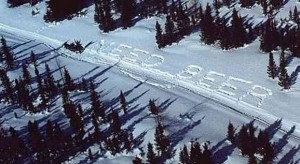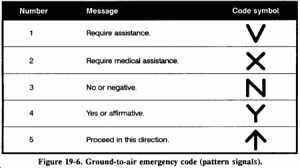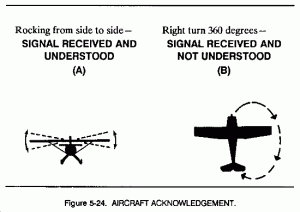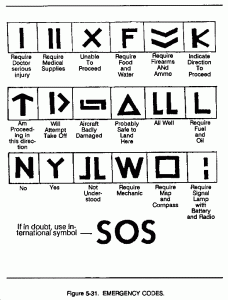Pulled these out of the FM 21-60 Chapter 5: Signals to Aircraft. These are internationally recognized signals that can be used with both fixed and rotary wing aircraft (planes and helicopters). Print these out and learn them if you have a few; the most likely symbol you will use in the civilian world will be the “require assistance” or “require medical assistance.”
These techniques are used in the absence of radio or other forms of communication. In a winter situation these can be made by “walking” out the desired message signal. These marks can also be made by lining stone and wood or scratching in soft soil.
5-3: c. Select a relatively flat, clear area of ground about 40 by 130 feet. This area is large enough to display messages and special signs. For message drop and pickup, the area should be clear of obstacles which could prevent aircraft from flying into the wind at reduced airspeed and low altitude.
5-3: f. An aircraft pilot indicates that ground signals have been understood by rocking the wings laterally, by flashing a green signal lamp, or by any prearranged signal (A, Figure 5-24). The pilot indicates that ground signals are not understood by making a 360-degree turn to the right, by flashing a red signal lamp, or by any prearranged signal.
5-5: c. Emergency Codes. The symbols for these codes may be constructed from any available material that contrasts with the background; for example, strips of parachute canopy, undershirts torn into wide strips, rocks, sticks, and foliage stripped from trees. Once laid out, these signals (codes) are semipermanent.
Of note is the rule of three for a situation if distress: three successive shots fired from a firearm, three successive blows from a whistle, three successive knocks of stick on stick or stone on stone; anyway, you get the point. Three fires in a triangular or line arrangement are also a signal if distress that can be visible both day and night; smoke and fire.
Jon






Leave a Reply